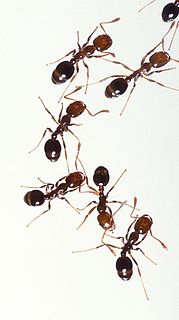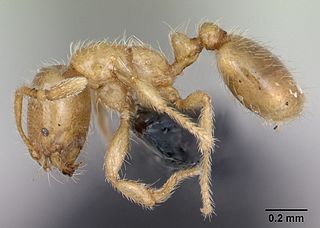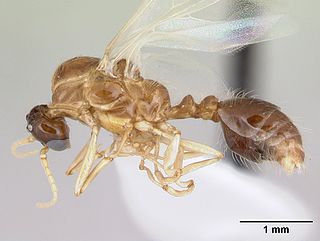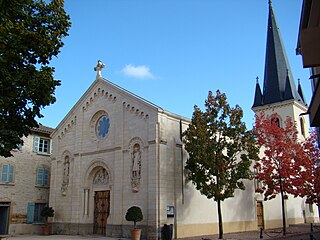Related Research Articles

Fire ants are several species of ants in the genus Solenopsis. They are, however, only a minority in the genus, which includes over 200 species of Solenopsis worldwide. Solenopsis are stinging ants, and most of their common names reflect this, for example, ginger ants and tropical fire ants. Many species also are called red ants because of their light brown color, though species of ants in many other genera are similarly named for similar reasons. Examples include Myrmica rubra and Pogonomyrmex barbatus.

The red imported fire ant, also known as the fire ant or RIFA, is a species of ant native to South America. A member of the genus Solenopsis in the subfamily Myrmicinae, it was described by Swiss entomologist Felix Santschi as a variant in 1916. Its current specific name invicta was given to the ant in 1972 as a separate species. However, the variant and species were the same ant, and the name was preserved due to its wide use. Though South American in origin, the red imported fire ant has been accidentally introduced in Australia, New Zealand, several Asian and Caribbean countries, and the United States. The red imported fire ant is polymorphic, as workers appear in different shapes and sizes. The ant's colours are red and somewhat yellowish with a brown or black gaster, but males are completely black. Red imported fire ants are dominant in altered areas and live in a wide variety of habitats. They can be found in rain forests, disturbed areas, deserts, grasslands, alongside roads and buildings, and in electrical equipment. Colonies form large mounds constructed from soil with no visible entrances because foraging tunnels are built and workers emerge far away from the nest.

Solenopsis fugax is a myrmicine ant of the genus Solenopsis.
Solenopsis is a scientific name for two genera:
Niten Ichi-ryū (二天一流), which can be loosely translated as "the school of the strategy of two heavens as one", is a koryū, transmitting a style of classical Japanese swordsmanship conceived by the warrior Miyamoto Musashi. Hyōhō Niten Ichi-ryū is mainly known for the two-sword—katana and wakizashi—kenjutsu techniques Musashi called Niten Ichi or Nitō Ichi.

Solenopsis daguerrei is a species of parasitic ants native to Argentina and Uruguay . The young queens of the species invade the nests of other species, such as the red imported fire ant (RIFA). This is made possible by the fact that the S. daguerrei queen produces pheromones which are very similar to those produced by the queens of the host species. The young queen finds a queen of the host species and latches onto it, eating the food intended for the host queen and slowly killing it. The S. daguerrei queen then begins laying eggs. These are taken care of by the host ants, sometimes preferentially to their own brood. S. daguerrei only produce winged virgin queens and males. No workers are needed, since these are provided by the host species. The winged ants fly off to mate and invade new colonies.

The Field Elm cultivar Ulmus minor 'Sowerbyi', commonly known as the Sowerby Elm, was described by Moss in The Cambridge British Flora (1914). The tree, once referred to as the 'Norfolk Elm' by Smith, was commonly found in the hedgerows and woods of Norfolk, Cambridgeshire, and Huntingdonshire in the early 20th century before the advent of Dutch elm disease. Melville considered it a hybrid of 'Coritana'.
Solenopsis solenopsidis is a species of ant in the genus Solenopsis. It is endemic to Argentina.

Solenopsis molesta is the best known species of Solenopsisthief ants. These ants, which include the majority of species within the genus Solenopsis, get their names from their habit of nesting close to other ant nests, from which they steal food. They are also called grease ants because they are attracted to grease. Nuptial flight in this species occur from late July through early fall.

Gleizé is a commune in the Rhône department in eastern France.

Solenopsis saevissima, commonly known in Brazil as formiga de fogo, formiga-vermelha, or formiga-lava-pes, is one of more than 185 species in the genus Solenopsis. It, along with 13 other species, is also a member of the Solenopsis saevissima species group which are popularly known as fire ants.

Alexgeorgea is a genus of three plant species found in Western Australia belonging to the family Restionaceae named in honour of the botanist Alex George in 1976. The flowers of the female and large nut-like fruit are completely underground except for the stigmas, which extend out of the ground as 3 purple or red threads.
The bignose conger is an eel in the family Congridae. It was described by David Starr Jordan and Charles Harvey Bollman in 1890. It is a tropical, marine eel which is known from the eastern central and southeastern Pacific Ocean, including Chile, Colombia, Costa Rica, Ecuador, El Salvador, Guatemala, Honduras, Mexico, Nicaragua, Panama, and Peru. It dwells at a depth range of 25–90 metres. Males can reach a maximum total length of 40 centimetres, but more commonly reach a TL of 30 cm.
Solenopsis is a genus of plants in the Campanulaceae. It is native to the Mediterranean region from Portugal and the Canary Islands east to Turkey.
The Field Elm cultivar Ulmus minor 'Viminalis Betulaefolia' (:'birch-leaved') is an elm of uncertain origin. An U. betulaefolia was listed by Loddiges of Hackney, London, in the catalogue of 1836, an U. campestris var. betulaefolia by Loudon in Arboretum et Fruticetum Britannicum (1838), and an U. betulifoliaBooth by the Lawson nursery of Edinburgh. Henry described an U. campestris var. betulaefolia at Kew in 1913, obtained from Fulham nurseryman Osborne in 1879, as "scarcely different from var. viminalis ". Melville considered the tree so named at Kew a form of his U. × viminalis, while Bean (1988), describing U. 'Betulaefolia', likewise placed it under U. 'Viminalis' as an apparently allied tree. Loudon and Browne had noted that some forms of 'Viminalis' can be mistaken for a variety of birch. An U. campestris betulaefolia was distributed by Hesse's Nurseries, Weener, Germany, in the 1930s.

Solenopsis amblychila is a species of ant native to the southwestern United States. It can withstand very dry conditions but may be found in well watered lawns, and is usually found to nest in soil, under rocks, or under pieces of wood. A notable trait of this species is its pale golden or yellow coloration which makes it commonly mistaken for Solenopsis aurea, which also has a golden coloration. Workers are known to be polymorphic, and contain both minor and major workers in colonies.

Solenopsis aurea, also commonly called the golden fire ant, is a species of ant native to the southwestern United States and Northern Mexico. Workers have a pale golden coloration with occasional brown spots.